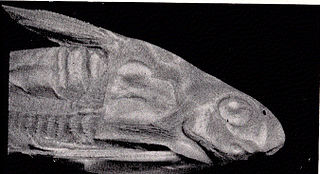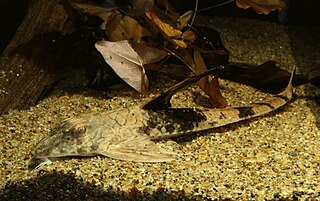
Hypostomus is a genus of catfish in the family Loricariidae. They are native to tropical and subtropical South America. H. plecostomus is the popular freshwater aquarium fish formerly known as Plecostomus plecostomus. The taxonomic structure of the Loricariidae is still being expanded by scientists. Hypostomus is a highly species-rich and widely distributed catfish genus.

The Doradidae are a family of catfishes also known as thorny catfishes, raphael catfishes or talking catfishes. These fish are native to South America, primarily the Amazon basin and the Guianas.

Hemiancistrus is a genus of suckermouth armored catfishes. These species are native to South America. The taxonomy of this genus is complex and unclear, and major work has to be done. Many of these fish are popular aquarium fish.

The striped Raphael catfish is a catfish of the family Doradidae. It may also be called Southern striped Raphael, talking catfish, chocolate doradid, chocolate catfish or thorny catfish. It is native to the Amazon, Paraguay–Paraná and lower Orinoco basins in South America. This peaceful, nocturnal species is a popular aquarium fish due to its pleasant temperament and curious nature. Despite its name "talking catfish", it does not speak.

Platydoras costatus, the Raphael catfish, is a species of thorny catfish native to rivers in Brazil, Suriname and French Guiana. It was long confused with other species in the genus Platydoras, especially the more widespread "true" striped Raphael catfish. P. costatus grows to a length of 24 cm (9.4 in) SL, and unlike P. armatulus the light stripe along the body of P. costatus does not extend onto the head. This fish is a minor component of local fisheries and is also found in the aquarium trade.

Platydoras is a small genus of thorny catfishes native to freshwater habitats in subtropical and tropical South America.
Scorpiodoras is a genus of thorny catfishes native to tropical South America.

Doras is a genus of thorny catfishes native to tropical South America.

Anadoras is a genus of thorny catfishes native to tropical South America.
Hemidoras is a small genus of thorny catfishes native to the Amazon basin in South America.
Rhinodoras is a genus of thorny catfishes native to South America.

Trachydoras is a genus of fish in the family Doradidae native to South America.
Nemadoras is a genus of thorny catfishes native to tropical South America.
Amblydoras is a genus of thorny catfishes native to rivers in tropical South America.

Leptodoras is a genus of thorny catfishes native to South America.
Rhynchodoras is a small genus of thorny catfishes native to South America. Rhynchodoras is closely related to Rhinodoras and Orinocodoras.
Hassar is a genus of thorny catfishes native to South America.

Loricaria is a genus of armored catfish native to South America.
Pseudobagarius is a genus of catfishes of the family Akysidae.
Centromochlus is a genus of fish in the family Auchenipteridae native to South America.










